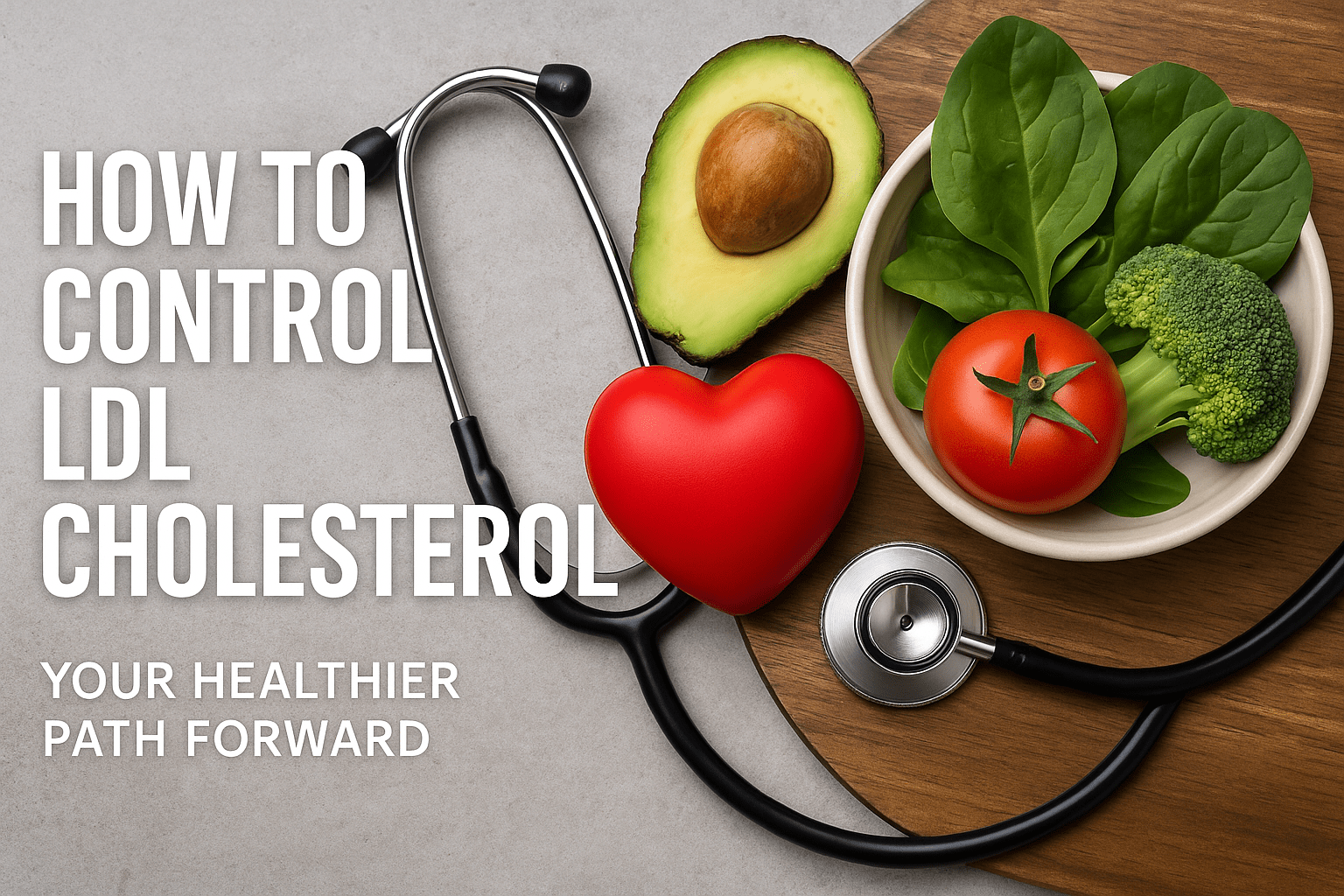
How to Control LDL Cholesterol: Your Healthier Path Forward
- Category: Health Awareness
- Date 17-09-2025
Lowering LDL bad cholesterol is not just necessary but a life-changing decision. LDL, or low-density lipoprotein, plays a crucial role in transporting fats in your blood. However, when its level in our bloodstream increases a lot, LDL can lead to plaque buildup in arteries, raising the risk of heart attacks, strokes, and cardiovascular issues.
Very high LDL cholesterol, defined as readings of 190 mg/Dl or more, is especially concerning. At this level, your risk of arterial blockage increases significantly, and proactive steps become a rapid necessity.
Luckily, there are specific effective strategies to reduce LDL cholesterol naturally, and they range from dietary adjustments to lifestyle shifts. Below is your comprehensive guide to how to control LDL cholesterol and keep it in the healthier range.
Understand Your LDL Cholesterol Levels
Doctors categorize LDL cholesterol as follows:
- Normal LDL: below 100 mg/dL
- Near-optimal: 100–129 mg/dL
- Borderline High: 130–159 mg/dL
- High: 160–189 mg/dL
- Very High LDL Cholesterol: 190 mg/dL and above
Knowing what number, you have is the first crucial step in deciding whether lifestyle changes alone are enough or you need medical support.
Step 1. Improve Your Diet When You Have Lower LDL Cholesterol Levels
Reduce saturated and trans fats
Foods that are rich in saturated fat, such as red meat, full-fat dairy, and tropical oils, and any trans fats can raise LDL significantly. Reducing the consumption of these items helps your body manage cholesterol better.
Add soluble fiber and plant-based foods.
Foods that are high in soluble fiber, such as oats, beans, lentils, apples, and certain vegetables, help lower LDL naturally by binding cholesterol and helping its elimination.
Include plant sterols
Natural compounds found in plants, such as phytosterols, can block cholesterol absorption, and they can help lower LDL. These are very effective, especially when paired with other healthy habits.
Step 2. Adopt Heart-Healthy Lifestyle Habits
Stay active
Indulging in regular workouts and exercises supports weight control, enhances cholesterol ratios, and lowers LDL cholesterol levels.
Maintain a healthy weight.
Carrying excess fat, especially around your waist, can quickly elevate your LDL levels. Losing weight, even in a modest amount, can bring down your cholesterol level.
Follow therapeutic lifestyle changes (TLC)
The TLC program, which is usually recommended, is:
- Less than 7% of daily calories from saturated fat
- Up to 20 g per day of soluble fiber
- Around 2 g per day of plant sterols
- At least 30 minutes of moderate activity most days
This structured approach targets LDL reduction without medications.
Step 3: Stay Physically Active
Regularly indulging in exercise improves your body’s cholesterol profile. Always focus on at least 150 minutes per week of moderate to high-intensity workout that can include brisk walking, cycling, swimming, or dancing. Exercise helps by increasing HDL cholesterol.
Exercise helps by increasing HDL cholesterol, which in turn helps clear LDL from the bloodstream. If you have very high LDL cholesterol, combining exercise with diet adjustments is especially powerful—it supports weight loss and helps prevent plaque buildup in your arteries.
Summary: Your Action Plan to Control LDL
|
Action |
Goal |
Benefit |
|---|---|---|
|
Improve diet |
Reduce saturated/trans fats, add eat more fiber & plant sterols |
Reduces cholesterol absorption and production |
|
Stay active |
At least 150 min/week of moderate exercise |
Raises HDL, helps lower LDL |
|
Maintain healthy weight |
Lose 5–10% of body weight if overweight |
Betters cholesterol profile |
|
Avoid smoking & excess alcohol |
Quit smoking, limit alcohol |
Protects blood vessels, prevents LDL damage |
|
Follow TLC plan |
Structured diet and exercise program |
Comprehensive LDL reduction |
|
Consider medication if needed |
Statins, PCSK9 inhibitors, etc. |
Rapid and significant LDL lowering |
Step 4: Quit Smoking and Limit Alcohol
Smoking damages blood vessel walls and lowers HDL cholesterol, which worsens the effect of high LDL. Therefore, quitting smoking improves your overall health immediately. Limiting alcohol is also important because it can raise cholesterol as well as triglyceride levels, adding stress to your cardiovascular system.
Step 5: Follow a Therapeutic Lifestyle Changes (TLC) Plan
The TLC program is a scientifically backed strategy recommended by several health experts:
- Less than 7% of total calories from saturated fat
- Under 200 mg of dietary cholesterol per day
- 2 grams of plant sterols or stanols daily
- 20–30 grams of fiber daily, with a focus on soluble fiber
- Regular aerobic exercise on most days of the week
Also Read - Benefits of Jeera Water
Step 6: Know When You Need Medication
Most of the time, lifestyle changes are enough, especially for those with very high LDL cholesterol due to genetic conditions, such as familial hypercholesterolemia. In such cases, medicines can be vital.
- Statins: First-line drugs that block cholesterol production in the liver.
- Ezetimibe: It helps to reduce the absorption of cholesterol in the intestines.
- PCSK9 inhibitors: Injectable medications for those who need aggressive LDL lowering.
- Bile acid sequestrants: Bind to bile acids and force the body to use cholesterol to make more.
The Bottom Line
Learning how to control LDL cholesterol is one of the most important steps you can take for long-term heart health. Through diet and exercise, weight management steps you can take for long-term heart health. Through diet, exercise, weight management, and lifestyle changes, you can significantly reduce LDL cholesterol naturally.
For those with very high LDL cholesterol, medical treatments may be necessary, but they work best when combined with healthy living. Every small step you take toward lowering your LDL is a big step toward protecting your heart.
Do not wait for high cholesterol to cause a serious problem. Take charge right away, get your cholesterol checked, start heart-healthy habits, and work with your healthcare provider to lower LDL cholesterol levels. Your future self will thank you for it.
